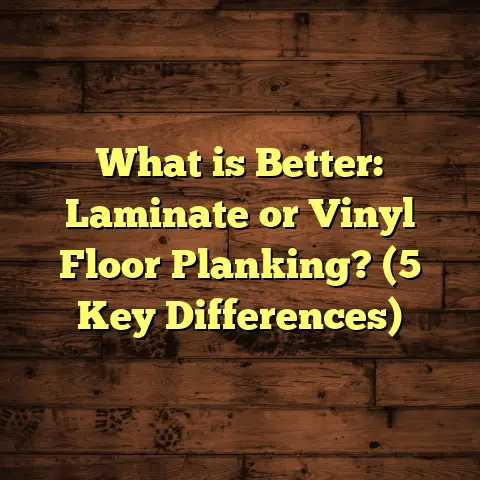What is a Neutral Floor? (7 Must-Know Benefits for Flooring)
Why did the floor break up with the carpet? Because it found someone more neutral!
Alright, let’s get into the world of flooring, and today we’re focusing on a concept that often gets overlooked: neutral floors. I’ve installed all types of flooring over the years, and one thing I’ve come to appreciate is the power of a neutral floor. It might sound simple, but trust me, there’s so much more to it than meets the eye.
Understanding Neutral Floors
When I talk about neutral floors, I’m referring to flooring options that feature soft, muted colors or shades that don’t clash with other design elements in a space. Think of colors like beige, gray, taupe, or even soft whites. These tones can create a beautiful backdrop for your interior design while allowing other elements—like furniture and decor—to shine.
The Color Palette
Neutral colors are typically described as those that lack strong chromatic content. They include shades such as:
- Beige: Often associated with warmth and comfort; it can range from light sandy tones to deeper caramel shades.
- Gray: A versatile color that can be both warm and cool. Light grays can make a space feel airy, while darker grays add sophistication.
- Taupe: A mix of brown and gray, taupe is a fantastic choice for those looking for something in between.
- Soft Whites: Not stark white, but rather off-whites that can provide a clean yet warm backdrop.
These colors can harmonize beautifully with a variety of design styles—from modern minimalism to rustic charm.
The Psychological Impact of Neutral Floors
It’s fascinating how color influences our emotions and perceptions. Neutral colors tend to evoke feelings of calmness and stability. In my years of experience, I’ve noticed that clients often comment on how peaceful they feel in rooms with neutral floors.
For example, I once worked on a yoga studio that had vibrant patterned tiles. While visually striking, students found it distracting during classes. After a renovation that included soft beige cork flooring, the atmosphere shifted dramatically; patrons felt more focused and at ease while practicing their poses.
7 Must-Know Benefits of Neutral Floors
1. Versatility in Design
I can’t tell you how many times I’ve walked into a home where the floor just didn’t match the vibe of the room. With neutral flooring, you avoid that problem entirely. They can adapt to various design styles—whether your home is modern, traditional, or eclectic.
Imagine a client who initially chose a bold red tile for their kitchen. After a year, they decided to redecorate. Guess what? The red tile was still there, clashing with their new color scheme. A neutral floor would have saved them from this dilemma.
Neutral floors allow you to be creative with your decor. You can easily switch from bohemian-style decor to sleek modern pieces without worrying about whether the flooring will match. The adaptability of neutral tones provides endless possibilities for reimagining your space.
2. Enhancing Natural Light
I’ve seen how light interacts with different floors. Neutral floors tend to bounce light around a room, making spaces feel brighter and more open. This is especially beneficial in smaller rooms or areas that lack ample natural light.
For example, I once renovated a small apartment with dark hardwood floors. It felt cramped and dim. Switching to a light gray laminate floor transformed the space; suddenly it felt airy and inviting!
In contrast, darker floors absorb light, which can make spaces feel smaller and less welcoming. If your home has large windows that let in natural light, neutral floors will reflect that brightness and create a warm atmosphere.
3. Timelessness
Trends come and go, but one thing remains constant: neutral floors have a timeless appeal. They never go out of style. Investing in a neutral flooring option means you won’t have to worry about your floors becoming outdated in a few years.
I often recommend clients choose neutral colors for their flooring if they plan to sell their home down the line. A neutral palette appeals to a broader audience, increasing the chances of a quick sale.
Consider this: homes with bold or unique flooring choices may find it difficult to attract buyers who have different tastes. But when potential buyers walk into a home with soft beige or light gray flooring, they can envision their own style without feeling restricted by someone else’s choices.
4. Easy Maintenance
Let’s be honest; some flooring materials show dirt and stains more than others. Neutral floors tend to hide imperfections better than darker or overly bright options. If you spill something (and we all do), it’s less likely to stand out on a medium beige floor compared to a stark white one.
I remember installing a beautiful dark espresso hardwood floor in a busy family kitchen only to find out how challenging it was to keep clean! The scratches and dust showed up like neon signs. Switching to a lighter neutral tone made maintenance much easier for them.
Moreover, most cleaning products are formulated for common stains and messes; having a neutral floor means you’re less likely to see discoloration from cleaning chemicals. This is especially relevant for households with pets or young children who may have frequent accidents.
5. Creating Space Illusion
If you’re aiming for that spacious feel in your home, neutral flooring can help achieve that illusion. Lighter colors tend to make rooms appear larger and more open, which is beneficial in compact spaces.
In one project, I worked on a small living room where the homeowner wanted it to feel bigger without expanding the walls. By using a soft taupe vinyl plank, we created an illusion of depth that made the room feel more expansive.
In addition to color choice, the texture of the flooring can also influence how spacious a room feels. For instance, smooth finishes reflect light better than textured surfaces; therefore, shiny neutral tiles can enhance the sense of space even further.
6. Coordination with Furniture
Have you ever tried matching furniture with bold or unique flooring? It can be quite the challenge! Neutral flooring serves as a blank canvas for your furniture and decor, allowing them to become the focal points of the room.
I’ve had clients who initially had vibrant patterned carpets but found it hard to coordinate with their furniture pieces. Once they switched to a neutral laminate floor, they could easily change up their furniture without worrying about clashing colors.
This flexibility allows homeowners to invest in statement pieces without being tied down by their flooring choices. A bold sofa or an artistic coffee table can shine brightly against a neutral backdrop without competing for attention.
7. Increased Home Value
Finally, investing in neutral flooring can increase your home’s resale value. Potential buyers appreciate spaces that are easy to personalize. When they see neutral floors, they envision their own design ideas rather than feeling boxed into someone else’s choices.
A study by the National Association of Realtors found that homes with neutral color palettes tend to sell faster than those with bold colors—up to 20% faster in some markets! That’s significant when you consider how much effort goes into selling a home.
Many real estate agents suggest that sellers repaint walls and replace flooring with neutral options before listing their homes because it maximizes appeal and increases offers from potential buyers.
Technical Specifications and Manufacturing Processes
Understanding the technical aspects of flooring helps in making informed decisions. Neutral floors can come from various materials—laminate, vinyl, hardwood, and tile—and each has different specifications and manufacturing processes.
Laminate Flooring
Typically consists of several layers:
- Core Board: Made from high-density fiberboard (HDF), this layer provides durability and moisture resistance.
- Decorative Layer: This is where the magic happens! The decorative layer features printed designs that mimic wood grain or other textures in those lovely neutral tones.
- Protective Wear Layer: This top layer protects against scratches and stains while enhancing durability.
The manufacturing process involves high heat and pressure to bind these layers together securely, resulting in durable flooring that’s both attractive and functional.
Vinyl Flooring
Made from polyvinyl chloride (PVC), it’s manufactured through a process called calendering, where layers are pressed together to form durable sheets or tiles.
Vinyl flooring is available in various forms—sheet vinyl, vinyl tiles, and luxury vinyl planks (LVP). LVP has become particularly popular due to its ability to mimic natural materials like wood or stone while offering water resistance and durability.
Hardwood Flooring
Often sourced from sustainable forests, hardwood undergoes drying and milling processes before being finished in various neutral stains.
There are two main types of hardwood: solid hardwood and engineered hardwood. Solid hardwood is cut directly from trees and offers longevity but can be sensitive to moisture changes. Engineered hardwood consists of layers bonded together for increased stability—making it suitable for basements or areas prone to humidity.
Cost Estimation
When it comes to budgeting for your flooring project, I’ve realized how crucial accurate cost estimation is. That’s where tools like FloorTally come into play for me. It simplifies calculations by providing precise estimates based on local material and labor costs.
For instance, if I’m working on a project that requires 1,000 square feet of laminate flooring in a neutral tone, FloorTally can help me quickly calculate total costs—including extras for waste management—without having to request multiple quotes from suppliers.
It saves time and provides clarity on budget allocations, which is invaluable when managing flooring projects.
In my experience, accurate cost estimation can help avoid unexpected expenses down the line. For instance, if you underestimate material needs or overlook labor costs associated with installation challenges (like moving furniture), your project might end up costing more than planned.
Personal Insights and Anecdotes
Reflecting back on my experiences as a flooring contractor, I remember one particular client who was adamant about having dark wood floors throughout their home. After several discussions and showing them examples of neutral options, they finally agreed to try out light oak flooring.
Not only did it brighten their home, but they also loved how easy it was to clean! It’s moments like these that reinforce my belief in the benefits of choosing neutral floors.
In another instance, I had a friend who was redecorating his living room. He opted for an intricate patterned carpet that quickly became outdated. When he finally switched to a simple beige laminate floor years later, he felt relieved because he could easily pair it with his evolving decor style.
One memorable project was for a couple who wanted their new home to reflect their love for nature but struggled with choosing colors. They were drawn towards vibrant greens and earthy browns but worried about how these would translate into their flooring choices. After discussing various options together, we settled on an elegant gray tile that mimicked natural stone—it provided just enough color without overwhelming the space! They were thrilled with the outcome!
Trends in Neutral Flooring
As we move through different design eras, trends emerge within the world of neutral flooring too! Here are some current trends I’m seeing:
- Textured Finishes: Homeowners are gravitating toward textured surfaces that add depth while still remaining neutral in tone.
- Large Format Tiles: Larger tiles minimize grout lines and create an uninterrupted look—perfect for open-concept spaces!
- Sustainable Materials: More people are considering eco-friendly options like bamboo or reclaimed wood which also offer beautiful neutral hues!
Staying updated on these trends not only helps me serve my clients better but also allows me to make suggestions based on what’s currently popular while still emphasizing timelessness!
Conclusion
Neutral floors offer countless benefits that go beyond aesthetic appeal. From versatility and maintenance ease to increased home value and timelessness, they provide an excellent foundation for any space.
So next time you’re considering new flooring, think about going neutral! It could be the best choice you ever make for your home—and who knows? You might just find yourself laughing at how smooth the transition really is!
Whether you’re looking for something contemporary or traditional—a neutral floor could be your ultimate solution!





